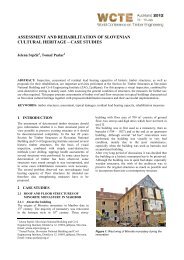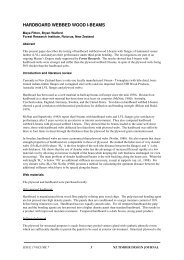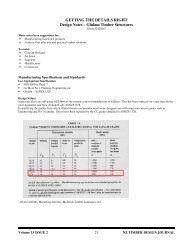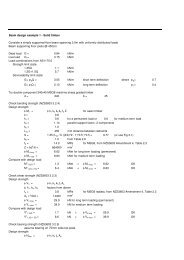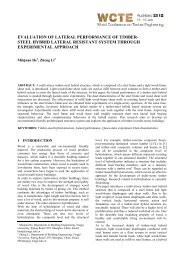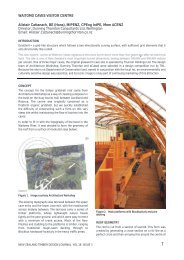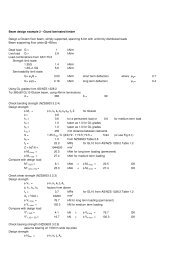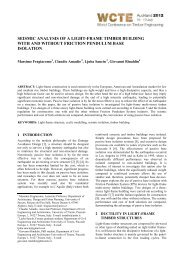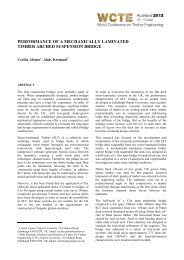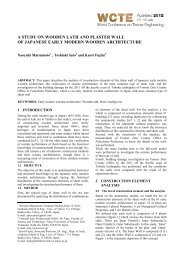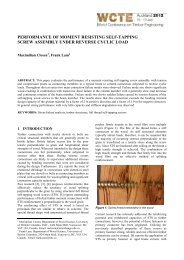Japan Kobe Earthquake Shake Table Simulation - Timber Design ...
Japan Kobe Earthquake Shake Table Simulation - Timber Design ...
Japan Kobe Earthquake Shake Table Simulation - Timber Design ...
Create successful ePaper yourself
Turn your PDF publications into a flip-book with our unique Google optimized e-Paper software.
Background<br />
<strong>Earthquake</strong> Performance of Multi-storey<br />
Cross Laminated <strong>Timber</strong> Buildings<br />
Dr Pierre Quenneville, Professor of <strong>Timber</strong> <strong>Design</strong>, The University of Auckland<br />
Mr Hugh Morris, Senior Lecturer, The University of Auckland<br />
On October 23 rd 2007, a seven storey Cross Laminated <strong>Timber</strong> building was tested on the world’s largest<br />
earthquake shake table at Miki near <strong>Kobe</strong> in <strong>Japan</strong>. Cross laminated timber construction and the preliminary<br />
earthquake and fire tests are overviewed. The huge E-Defense shake table facility in <strong>Japan</strong> and the test<br />
building are described and the earthquake records used to test the building. The building performed well<br />
when subjected to the severe <strong>Kobe</strong> earthquake record. It had some minor softening and no residual deformation.<br />
Accelerations measured within the building were large and need further design consideration.<br />
Professor Ario Cecotti of the Trees and <strong>Timber</strong> Institute (CNR Ivalsa 1 ) in Italy has undertaken a substantial research<br />
programme into the German / Austrian cross-laminated timber technology (Project SOFIE 2 ). The project was sponsored<br />
by the Province of Trento to use Italian wood in the cross-laminated timber panels shipped to <strong>Japan</strong> for the full scale<br />
earthquake test buildings. Two years ago, a three storey building was tested in Tsukuba. This was preliminary to the seven<br />
storey tests at Miki in collaboration with three <strong>Japan</strong>ese partners, the National Research Institute for Earth Science and<br />
Disaster Prevention NIED, the Building Research Institute BRI, and Shizuoka University. Hugh and Pierre were privileged<br />
to be able to take up the invitation to observe the final test which drew substantial media attention. It was timed to fit an<br />
“Italian Spring” promotion in <strong>Japan</strong> with representatives present from the Province of Trento and the Italian embassy.<br />
Cross laminated <strong>Timber</strong> Construction<br />
<strong>Japan</strong> <strong>Kobe</strong> <strong>Earthquake</strong> <strong>Shake</strong> <strong>Table</strong> <strong>Simulation</strong><br />
Cross-laminated timber consists of strips of lumber stacked on top of each other at a 90° angle and glued together under<br />
high pressure to become large-sized solid cross-laminated boards. Depending on requirements, the board can have three,<br />
five or seven layers. The strips vary in thickness between 19 and 40 mm (see Figure 1). As for the glue-laminated technology,<br />
cross-laminated boards can be fabricated using low-grade lumber within the core of the boards and with higher grade<br />
pieces on the outside. This has the advantage that a wider range of board densities can be used for this engineered wood<br />
product.<br />
Figure 1. Detail of cross-laminated board.(Middle board has tension rings<br />
running in opposite direction to outside two boards)<br />
Cross-lamination of the strips minimises shrinkage and swelling while increasing static strength and shape retention<br />
properties. The loads can be transferred on all sides, as a true plate and sheet action. Some forms of cross-laminated boards<br />
are fabricated using aluminium nails to permit machining without damaging the cutting tools.<br />
The separate layers of lumber are glued using interior/exterior polyurethane adhesives. The glues are formaldehyde and<br />
solvent free adhesives. The solid cross-laminated boards are usually fabricated in industrial quality but visible interior<br />
application standards are also possible on demand but require extra care during handling.<br />
The boards can be trimmed to size at the manufacturing site or cut on site (see Figure 2). The fabrication of large elements<br />
and the prefabrication of wall segments in factories protected from the weather are requirements that can also apply to<br />
timber construction. These boards have the advantage that they can be delivered to the construction site easily and quickly<br />
and ready for finishing (see Figure 3). They can be manufactured with the maximum length, width and depth of 16.5 m,<br />
2.95 m and 0.6 m respectively.<br />
ISSUE 4 VOLUME 15<br />
3<br />
NZ TIMBER DESIGN JOURNAL
Figure 2. Cross-laminated panel cut to shape and ready for delivery.<br />
Figure 3. Cross-laminated industrial building under construction.<br />
Since they are structural elements as such, they can be used as both building envelopes and structural members. For spans<br />
too long or loads too high, their use can be combined with other structural members such as sawn timbers or more<br />
commonly glue-laminated columns, beams and trusses.<br />
Research Background<br />
The mechanics behind the cross-laminated technology are not different from beam and plate theories. However, one has<br />
to take into account the reduced stiffness of the laminations that are laid at 90°. The cross layers result in increased<br />
deflections for a given element depth. As well, rolling shear, as for plywood, becomes important and must be verified.<br />
Most of the research has been done in Germany and Austria. It is already accepted within the German design code.<br />
Research has shown that the cross-laminated board elements includes the laminating effect of the glue-laminated beams<br />
and the system effect observed for equally spaced similar members (Jobstl et al., 2006). More research on various<br />
connections techniques is being undertaken presently.<br />
Three Storey Building Tests<br />
In 2006, the Italian Trees and <strong>Timber</strong> Institute – CNR Ivalsa, initiated the testing project to evaluate the seismic resistance<br />
of a three storey timber building, constructed using cross-laminated boards (see Figure 4). The building was approximately<br />
7m x 7m in plan.<br />
Following the results of a series of pseudo-dynamic tests on small cross-laminated board assemblies, the research team<br />
subjected the three storey cross-laminated timber building specimen to a series of seismic records on the Tsubuka, <strong>Japan</strong><br />
shake table. The building performed adequately, returning to its original position after both the El-Centro and <strong>Kobe</strong><br />
earthquakes.<br />
ISSUE 4 VOLUME 15<br />
4<br />
NZ TIMBER DESIGN JOURNAL
Figure 4. Three storey cross-laminated<br />
building tested on second largest shake<br />
table in Tsukuba <strong>Japan</strong>.<br />
The building was then moved to another location in order to conduct a fire<br />
test (see Figure 5). The test consisted of initiating a fire in one of the corner<br />
rooms of the building. Mattresses and wood were added to simulate a typical<br />
bedroom contents. All walls and ceilings were covered with gypsum boards.<br />
The temperature in the test room attained 1000°C. The temperature in all of<br />
the adjacent rooms remained at approximately 20°C. The fire was allowed<br />
to proceed for more than an hour. A significant amount of char formed on<br />
the surfaces of the cross-laminated building elements, following the failure<br />
of the gypsum board fastenings. The building passed the required fire test.<br />
Seven Storey Test building<br />
A seven storey building using cross-laminated<br />
components was fabricated and shipped from Italy.<br />
A five storey section was built and lifted onto the<br />
shake table. The top two storeys were then lifted<br />
on top and connected. The whole 23.2m high<br />
building was erected in a little over a week (see<br />
Figure 6).<br />
Figure 5. Three storey cross-laminated building fire tested<br />
after the earthquake tests.<br />
The fourth floor typical plan is shown in Figure 7 although level two had less<br />
cross walls and was the lowest in stiffness. The building used 250m 3 of timber<br />
and weighed 120 tonnes. Each floor had an additional 30T of mass to simulate<br />
the weight of concrete floor topping, linings and internal fixtures. The lower<br />
walls and all floors were 142mm thick and upper level cross-laminated walls<br />
were thinner.<br />
Figure 6. Photograph of test building<br />
in the test facility.<br />
ISSUE 4 VOLUME 15<br />
5<br />
NZ TIMBER DESIGN JOURNAL
7.7m<br />
Figure 7. Level 4 layout of seven storey<br />
cross-laminated test building.<br />
Wall<br />
Thickness<br />
85mm<br />
23.2m<br />
125mm<br />
142mm<br />
15m<br />
E-defense Facility<br />
Figure 8. Seven storey cross-laminated test<br />
building dimensions and wall thicknesses.<br />
The tests on the seven storey building were undertaken on the largest earthquake shake table in the world, located at Miki<br />
near <strong>Kobe</strong> in <strong>Japan</strong> (see Figure 9). This facility is vast. It was excavated about 10 storeys deep in order to reach bedrock<br />
and to install the 8m long hydraulic rams. The table size is 20m x 15m (about the playing area of a tennis court) and can<br />
carry a 1200T building. It can apply vertical accelerations of around 2g and horizontal accelerations of 1g. It can move<br />
up to 1m horizontally and has 6 axes of motion (Figure 10). This facility was constructed so that full-scale three storey<br />
reinforced concrete buildings could be tested under realistic seismic conditions.<br />
ISSUE 4 VOLUME 15<br />
6<br />
NZ TIMBER DESIGN JOURNAL
Figure 9. Aerial photograph of huge E-defense shake table facility.<br />
<strong>Earthquake</strong> Records<br />
Figure 10. Model of E-defense shake table showing axes of motion and scale.<br />
In October 2007, the seven storey building was subjected to a 50% <strong>Kobe</strong> record on October 20 and the full <strong>Kobe</strong> 3-D<br />
record was applied at the first test we witnessed on October 23 rd . This is a well recorded, severe near fault record that is<br />
well in excess of what is anticipated in Italy but which has a huge significance in <strong>Japan</strong>. As extracted from Kitada et al. 3<br />
and shown in Figure 11, the maximum horizontal accelerations are 0.82g N-S and 0.60g E-W. The maximum vertical<br />
acceleration was 0.34g.<br />
Acceleration Response Spectra<br />
Acceleration (m/s2)<br />
NS<br />
EW<br />
Acceleration (m/s2)<br />
Period (s)<br />
Maximum 0.82g<br />
NS<br />
Acceleration (m/s2)<br />
Maximum 0.60g<br />
EW<br />
Figure 11. Horizontal acceleration record and response<br />
spectra for the 1995 <strong>Kobe</strong> earthquake.<br />
ISSUE 4 VOLUME 15<br />
7<br />
NZ TIMBER DESIGN JOURNAL
Test Results<br />
Official publications are not yet available but it was clear that the seven storey building performed very well and appeared<br />
to respond little beyond the elastic range with major components clearly stable and responding well. The building made<br />
loud noises as it moved but there was no damage visible from the viewing area. The team of researchers who had access<br />
to the test specimen reported that some of the screw connections for the panel hold-downs needed to be repositioned as<br />
they had failed. This is considered minor as long as the overall integrity of the building was retained. Moreover, one could<br />
easily plan for the easy re-location of these hold-downs in future construction.<br />
Shortly after the 100% <strong>Kobe</strong> earthquake test, the coordinators reported that there was no residual deformation, the maximum<br />
inter-storey drift was 40mm, and the maximum lateral deformation did not exceed 300mm. Engineers operating the facility<br />
reported that this was the tallest building they have tested and that its performance was much better than a pre-stressed<br />
concrete building subjected to the same record two weeks earlier.<br />
The maximum accelerations within the building from the <strong>Kobe</strong> input were 4g in the X direction and 2g in the Y direction.<br />
Before the tests, a modest 0.3g excitation was applied to determine the building response frequency - in one direction this<br />
was 2.5 Hz. Following the test, it was measured at 2Hz, indicating a softening of the structure attributed to connection<br />
loosening.<br />
The second test of the day had lower accelerations which meant that there was significantly less response. We would have<br />
preferred to see larger earthquake inputs to see the collapse mechanism or significant loading into the inelastic range. The<br />
success meant that the building was going to be reassembled as a student accommodation facility in Italy.<br />
Conclusions<br />
In this test, the cross-laminated technology proved adequate in resisting the seismic actions imposed and in the ability to<br />
offer the flexibility to engineers to re-position hold-down anchors following a major seismic event. The fact that none of<br />
the cross-laminated boards were damaged significantly and that the whole structure was dismantled, shipped back and<br />
re-used in Italy is a proof that wood structures can be used efficiently in structures and that they can be recycled. All of<br />
these cross-laminated boards could be used in other structures, under different environments.<br />
The earthquake test clearly demonstrated that the building was very stable under this severe level of shaking. The video<br />
sequences showed that this deformation was more severe than we could see from the observation point but it was well<br />
within acceptable limits. Video of the interior of the building showed a table moving very rapidly about a meter and chairs<br />
being thrown to the ground. The 4g accelerations within the building would endanger the lives of building occupants in<br />
New Zealand or <strong>Japan</strong>, the maximum earthquake anticipated in Europe is nearer 0.3g so there is less potential danger.<br />
As a stiff lightweight system and with the addition of a lower floor, this building would be ideally suited to a seismic<br />
isolation system.<br />
This event demonstrated the ability of the timber construction industry to adapt to new markets. An engineered timber<br />
material was pre-fabricated in Italy and then shipped in containers to <strong>Japan</strong> for erection. This building was subjected to<br />
two of the most severe recent <strong>Japan</strong>ese earthquakes and survived without significant damage or residual displacements<br />
and then, was shipped back to be re-used as a student residence in Italy. This is a great example of sustainable construction.<br />
New Zealand, with its vast timber resources, should develop this technology for domestic construction and export markets.<br />
References<br />
1. www.ivalsa.cnr.it<br />
2. www.progettosofie.it<br />
3. KITADA Yoshio, UMEKI Yoshito, AKASHIMA Kenji, “Near-Field <strong>Earthquake</strong> to be provided by <strong>Japan</strong>”<br />
http://icasp9.berkeley.edu/~boza/research/IRSN/CAMUS-reports/NF-motions-<strong>Japan</strong>.doc. Accessed Nov 2007.<br />
4. Jobstl, R.A., Moosbrugger, T. Bogensperger, T. and Schickhofer, G. “A Contribution to the <strong>Design</strong> and System Effect<br />
of Cross Laminated <strong>Timber</strong> (CLT).” paper 39-12-4, proceedings of the 2006 Annual CIB-W18 meeting, Florence, August<br />
2006.<br />
5. Progetto Sofie, October 2007, “Schedule of the shake table test”, document issued in visitor folder at Miki in <strong>Japan</strong>.<br />
ISSUE 4 VOLUME 15<br />
8<br />
NZ TIMBER DESIGN JOURNAL



